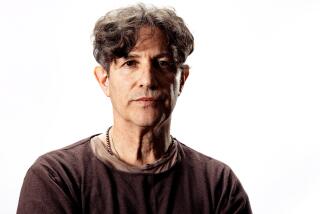Review: German art, history and politics come together in the moving, layered âNever Look Awayâ
âNever Look Away,â an absorbing and ruminative new drama from the German writer-director Florian Henckel von Donnersmarck, begins in Dresden in 1937. The world is about to tilt into madness, a condition that seems to manifest itself early on in the brave, troubled mind of a young woman named Elisabeth (Saskia Rosendahl). Her nephew, an aspiring painter named Kurt (Cai Cohrs), walks in to find her playing the piano in the nude; when he flinches, she tells him, âNever look away. Everything thatâs true is beautiful.â
The movie certainly makes its own case for beauty, evident in the crisp, gleaming frames of Caleb Deschanelâs cinematography and the lush strains of Max Richterâs orchestral score. As for truth, it would be hard to deny the emotional acuity of the performances or the moral clarity with which Von Donnersmarck confronts some of the horrors that Germany perpetrated and endured during the 20th century.
But those horrors â the epic conflagration of World War II, the brutal rise of the German Democratic Republic â also reveal the lie in Elisabethâs sentiment. The truth is often grievously ugly, and âNever Look Away,â though itâs as pretty and polished a piece of filmmaking as you are likely to see this year, does not shy away from acknowledging as much.
This is a long picture, running more than three hours and spanning a few decades, but Von Donnersmarck, a master of pacing, hooks you almost immediately. Much of the trauma is front-loaded: The warning signs of mental illness land Elisabeth in a Dresden hospital where Carl Seeband (Sebastian Koch), a top gynecologist, has her sterilized and transferred to an institution from which she will not return. One of the key concerns of âNever Look Awayâ is the systemic medical depravity that flourished in the Third Reich, where practitioners like Seeband ruthlessly exercised their state-given authority to sentence anyone they deemed inferior to infertility and even death.
If biological reproduction as a necessary human freedom is one of the pictureâs key themes, then the right to artistic creation is another. Years later, after losing Elisabeth and most of his family in World War II (harrowingly dramatized in a 1945-set montage), Kurt â now a bookish, thoughtful young man played by Tom Schilling â sets out to realize his longstanding dream of becoming a painter. He finds himself at an art academy in Dresden, now part of East Germany, and quickly learns that communism, which enforces a rigid aesthetic of socialist realism, is no more hospitable to the artistic soul than Nazism was.
While at school he does meet Ellie (Paula Beer), a lovely young student whose own thoughts, feelings and artistic aspirations surely warranted more of this movieâs ample running time. Kurt and Ellie fall in love, marry and eventually escape to the West by train, not long before the Berlin Wall goes up. There, Kurt joins the forward-thinking avant-gardists at the Art Academy in DĂźsseldorf, where drip paintings and slashed canvases abound. But even a modern, experimental sensibility doesnât supply Kurt with the inspiration he needs; that can only be found in the recent past, where unavenged ghosts cry out to be brought into sharp, photorealistic relief.
Like Von Donnersmarckâs remarkable 2006 debut feature, âThe Lives of Othersâ â and rather unlike his misbegotten Hollywood follow-up, âThe Touristâ (2010) â âNever Look Awayâ burrows into the heart of a bitterly divided Germany and asks what role, if any, art can play in times of political chaos and moral confusion. But in contrast with âThe Lives of Others,â the movie is not chiefly concerned with the transformation of an individualâs conscience. The lines between good and evil are clearly demarcated at the outset and remain more or less fixed as the story progresses, a strategy that in no way compromises the filmmakerâs ability to mine fresh complications and surprises from his story.
Fate conspires to bring Kurt and Seeband, his auntâs killer, into breathtakingly close proximity, though neither suspects the dark, painful history they share. (Koch, who played the dissident writer in âThe Lives of Others,â uses his elegant hauteur to much more sinister ends here.) One of Von Donnersmarckâs points is that we are connected not only more than we suspect, but also more than we may ever know. History does not always dispense easy solutions and just deserts, and the directorâs most daring stroke here is to take a time-bomb scenario and, rather than orchestrating the revelations for maximum explosive impact, allowing it to simmer until it seems in danger of burning out.
But not, at any point, of losing the viewerâs interest. This is partly because Von Donnersmarck himself, utilizing fine brushstrokes as well as broad ones, seems so interested by everyone and everything that passes across his canvas. He is troubled by the irony that, in the brutal aftermath of a fascist regime, it is decent, ordinary men like Kurtâs father (JĂśrg SchĂźttauf) who are more likely to suffer punishment than the Carl Seebands of the world. And he is no less attentive to the ways in which even ideologically opposite regimes can lapse into the tactics of repression and fearmongering.
More than anything, the director seems genuinely engaged, even inspired, by the aesthetic conundrum that haunts Kurt for much of the picture: how to use his passion for painting, increasingly viewed as a dying medium, to represent a newly broken world. Kurtâs story is loosely inspired by that of the great German artist Gerhard Richter, who in the 1960s pioneered a style of oil painting that reproduced some of the visual effects of camera photography. Those techniques would eventually lead Richter in a more abstract, pictorially free-form direction, one that falls beyond this movieâs sensibility and purview.
âNever Look Awayâ is nothing if not classical in its approach: It is stately and composed, clear-eyed and engrossing. It contains decorous scenes of lovemaking and childbirth that might strike you as tasteful to the point of sanitized. It seems tailor-made, in many respects, for the tastes of the motion picture academy voters who handed âThe Lives of Othersâ an Oscar for best foreign-language film, and who might be hoping for this 2018 German submission to work similar wonders. They might be disappointed. Or they might find themselves hard-pressed to disobey the title.
------------
âNever Look Awayâ
Rated: R, for graphic nudity, sexuality and brief, violent images
Running time: 3 hours, 8 minutes
Playing: Laemmle Royal, West Los Angeles
[email protected] | Twitter: @JustinCChang
More to Read
Only good movies
Get the Indie Focus newsletter, Mark Olsen's weekly guide to the world of cinema.
You may occasionally receive promotional content from the Los Angeles Times.











